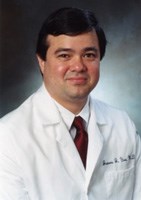A Yale orthopedic spine surgeon has a minimally invasive solution for patients with moderate to severe low back pain and sciatica caused by disk herniation. Specifically, he is targeting people whose pain doesn't improve with physical therapy or painkillers, but may not be severe enough to warrant open-spine surgery.

James J. Yue, MD
James J. Yue, MD, co-director of the Yale Orthopedic Spine Service, recently performed what he believes may be the first three cases of minimally invasive endoscopic spine surgery in New England, using a procedure that he has observed as it has developed over the past several years in the United States, Asia and Europe. Dr. Yue also has used the procedure to treat other patients at medical centers throughout the world.
One of his patients was Peter Lee, a regional sales manager for a national nonprofit. Rear-ended in a car accident in 2011, Lee had "excruciating" back pain that got so bad that he had to give up yard work, coaching and golf with his son. The pain meant he could no longer drive around his sales territory, and he eventually lost his job. After imaging revealed a disk herniation, he opted for the endoscopic surgery in late February, knowing that he could return for traditional surgery if the procedure didn't help.
"This procedure was amazing," said Lee. Although he had the option of staying overnight at the hospital, he felt well enough to go home the same day, and was able to go for a walk with his son a few days later. "Clearly it's going to take time for it to heal completely, but everyone says I look great. I'm very optimistic that my life is going to get back to normal quicker due to this new procedure, and I look forward to returning to work."
Surgery is not widely available
Although surgeons have provided the FDA-approved surgery in other parts of the country for years, it is not widely available because few surgeons currently have both the arthroscopic and spinal training necessary to perform it, says Dr. Yue. "You have to be able to look through a scope and orient yourself in the spine at the same time."
Disks in the spine allow motion and act like shock absorbers or cushions between the individual vertebrae. "The disk has a soft, well-hydrated, gelatinous-like center called the nucleus," says Dr. Yue. "In a normal disk, the nucleus stays within a layered ring restrictor called the annulus. When you get a small tear in the rings, the nucleus can leak out through a tear in the annulus." The annulus has sensitive nerves that can produce low back and leg pain severe enough to disable the patient.
Usually the surgery is performed in an outpatient setting using local anesthesia, and takes 45 to 90 minutes depending on the complexity of the problem. The patient lies face-down while the surgeon inserts an endoscope-a thin tube with a tiny video camera at the end of it-through an incision of less than a quarter of an inch, then guides it to the herniated disk. The surgeon grasps the disk and removes it, then seals the tear so the leakage stops. As he works, he is guided by the camera's view, which is projected onto a video screen.
A solution for more patients
Unlike traditional spinal surgeries, minimally invasive surgery does not disrupt major back muscles, thereby sparing patients additional pain and scarring. Patients can expect speedy recoveries and a decreased risk of muscle trauma and infection.
Most people don't need surgery for a herniated disk because their symptoms improve over time, sometimes with the help of physical therapy or painkillers. But, Dr. Yue says, many patients can't find relief from mild to moderate lumbar disk herniation, low back pain, or sciatica. Of those, 80% won't have problems severe enough to qualify for traditional operations.
"Their only other options would be to live with chronic pain, which means having difficulty sitting for long periods of time or with such activities as lifting laundry baskets. Some have to leave work and go on disability. So for patients who may otherwise have been deemed 'lost to care,' endoscopic surgery can bridge the gap," he says.





























